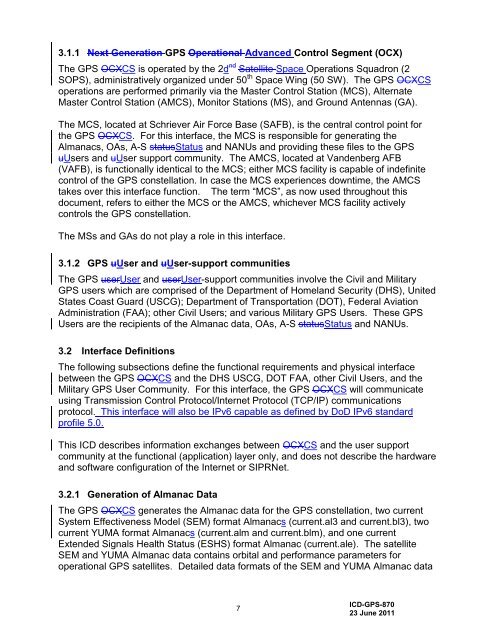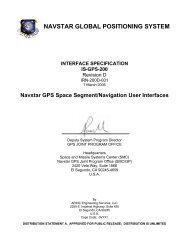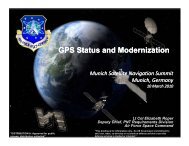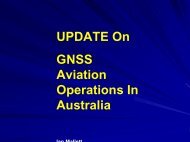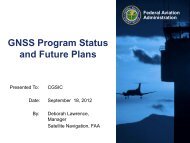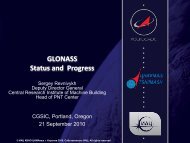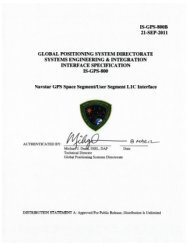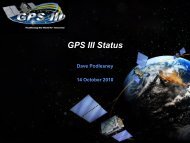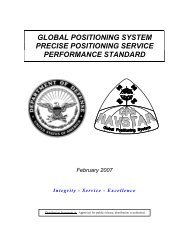DISTRIBUTION STATEMENT A APPROVED FOR ... - GPS.gov
DISTRIBUTION STATEMENT A APPROVED FOR ... - GPS.gov
DISTRIBUTION STATEMENT A APPROVED FOR ... - GPS.gov
Create successful ePaper yourself
Turn your PDF publications into a flip-book with our unique Google optimized e-Paper software.
3.1.1 Next Generation <strong>GPS</strong> Operational Advanced Control Segment (OCX)<br />
The <strong>GPS</strong> OCXCS is operated by the 2d nd Satellite Space Operations Squadron (2<br />
SOPS), administratively organized under 50 th Space Wing (50 SW). The <strong>GPS</strong> OCXCS<br />
operations are performed primarily via the Master Control Station (MCS), Alternate<br />
Master Control Station (AMCS), Monitor Stations (MS), and Ground Antennas (GA).<br />
The MCS, located at Schriever Air Force Base (SAFB), is the central control point for<br />
the <strong>GPS</strong> OCXCS. For this interface, the MCS is responsible for generating the<br />
Almanacs, OAs, A-S statusStatus and NANUs and providing these files to the <strong>GPS</strong><br />
uUsers and uUser support community. The AMCS, located at Vandenberg AFB<br />
(VAFB), is functionally identical to the MCS; either MCS facility is capable of indefinite<br />
control of the <strong>GPS</strong> constellation. In case the MCS experiences downtime, the AMCS<br />
takes over this interface function. The term “MCS”, as now used throughout this<br />
document, refers to either the MCS or the AMCS, whichever MCS facility actively<br />
controls the <strong>GPS</strong> constellation.<br />
The MSs and GAs do not play a role in this interface.<br />
3.1.2 <strong>GPS</strong> uUser and uUser-support communities<br />
The <strong>GPS</strong> userUser and userUser-support communities involve the Civil and Military<br />
<strong>GPS</strong> users which are comprised of the Department of Homeland Security (DHS), United<br />
States Coast Guard (USCG); Department of Transportation (DOT), Federal Aviation<br />
Administration (FAA); other Civil Users; and various Military <strong>GPS</strong> Users. These <strong>GPS</strong><br />
Users are the recipients of the Almanac data, OAs, A-S statusStatus and NANUs.<br />
3.2 Interface Definitions<br />
The following subsections define the functional requirements and physical interface<br />
between the <strong>GPS</strong> OCXCS and the DHS USCG, DOT FAA, other Civil Users, and the<br />
Military <strong>GPS</strong> User Community. For this interface, the <strong>GPS</strong> OCXCS will communicate<br />
using Transmission Control Protocol/Internet Protocol (TCP/IP) communications<br />
protocol. This interface will also be IPv6 capable as defined by DoD IPv6 standard<br />
profile 5.0.<br />
This ICD describes information exchanges between OCXCS and the user support<br />
community at the functional (application) layer only, and does not describe the hardware<br />
and software configuration of the Internet or SIPRNet.<br />
3.2.1 Generation of Almanac Data<br />
The <strong>GPS</strong> OCXCS generates the Almanac data for the <strong>GPS</strong> constellation, two current<br />
System Effectiveness Model (SEM) format Almanacs (current.al3 and current.bl3), two<br />
current YUMA format Almanacs (current.alm and current.blm), and one current<br />
Extended Signals Health Status (ESHS) format Almanac (current.ale). The satellite<br />
SEM and YUMA Almanac data contains orbital and performance parameters for<br />
operational <strong>GPS</strong> satellites. Detailed data formats of the SEM and YUMA Almanac data<br />
7<br />
ICD-<strong>GPS</strong>-870<br />
23 June 2011


